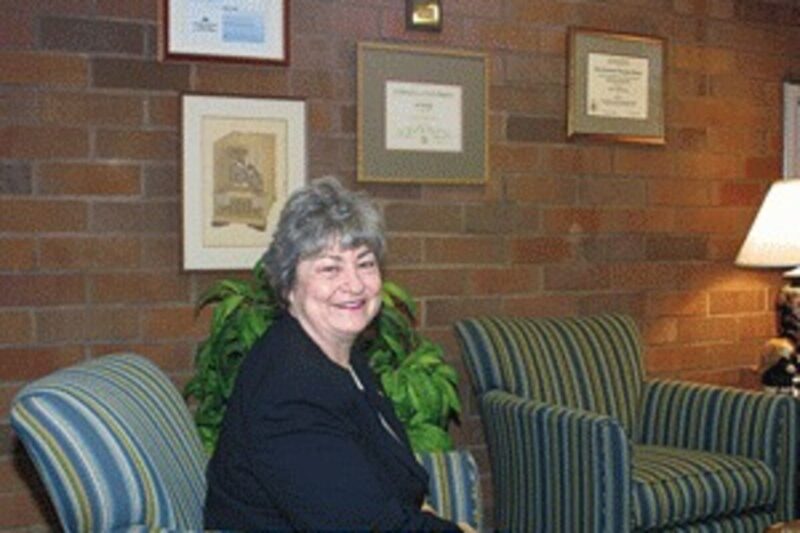Alex Paul
It takes only a few seconds to realize that Dr. Rita Cavin is excited about her life and of those who surround her at work and home.
The new president of Linn-Benton Community College said other than being separated for a few months from her husband, the transition to Oregon has been overwhelmingly positive.
“I never realized how difficult it would be only seeing my husband for four days a month,” Dr. Cavin said.
That situation will soon be rectified when her husband, Brooks, retires in March as a professor of architecture at Cal Poly University. He also is a partner in an architectural firm that specializes in developing energy efficient structures.
“He’s very excited about moving to Oregon,” Dr. Cavin said, “because he loves to fish.”
Her new role as a college president, after serving as a vice president at two colleges in California, suits the gregarious Cavin to a tee.
“I chose library science as my college major because I have so many interests, I couldn’t settle on one area,” Dr. Cavin admits with a laugh when queried about her career start.
A classroom teacher of English for two years in the San Bernardino School District, Dr. Cavin was a librarian at the Pamona Public Library from 1967-1969 and librarian of the graduate law and undergraduate libraries at the University of LaVerne from 1970-72.
She shifted to technical services librarian at Rio Hondo College from 1973-79 and learning resources director at Citrus College from 1979-86.
There, she rose to become Dean of Administrative and Cultural Services from 1990-92.
She was vice president of instruction at Mt. San Antonio College in Walnut, Calif. from 1997-2003. The college serves 40,000 students and offers 92 Associate in Science Degree majors and 101 occupational certificate programs. The college recently passed a $221 million bond to pay for 17 major projects and new construction. It campus encompasses more than 421 acres.
“I’m been lucky,” Dr. Cavin jokes, “in more than 30 years in education, I’ve never had to pick a major but I’ve always liked education, I like helping people.”
As a librarian, Dr. Cavin said she also was fortunate to be able to work with students without “having to grade anyone.”
“I was able to interact with students as they progressed at their own pace,” Dr. Cavin said. “There were no grades, no roll taking and no pop quizzes.”
But, Dr. Cavin quickly notes, being liked by students or staff is not part of her character profile.
“I’ve spent the last 15 years having to make decisions about salaries, tenure, job rejections and giving students bad news at times,” she said. “I keep my deep relationships away from the people with whom I work. I like to see myself as a mentor for them, an encourager.”
A product of the community college system, Dr. Cavin said she was encouraged at age 40 to begin her doctoral work by a college president.
Her thesis was on the shift from college staff thinking of themselves as professionals to that of laborers, as education became a unionized field.
While the transition to Oregon has been a smooth one, Dr. Cavin said there are major differences in the way the two states approach community colleges.
“There are 107 community colleges in California, all run through one system, all with the same tuition schedules,” she said. “Yet, they are all very competitive of each other. In Oregon, there are 17 community colleges, all operating somewhat on their own, and yet all seem to be so supportive of each other. I’ve had hone calls and emails from numerous other presidents all very supportive of my new job.”
Dr. Cavin said she was fully aware of Oregon’s financial issues when she interviewed for the job.
“It’s nothing compared to California,” she said. “I had been a vice president to four presidents over the last 11 years. I filled in for them when they were gone. In time, you start to second guess them and that’s not healthy waiting for someone to retire.”
Dr. Cavin said she set several criteria when choosing to seek a president’s job.
“I had a nice job at a nice college,” she said. “I knew that I didn’t want a fixer upper college. I wanted it the community to be someplace where I wanted to live and of a medium size. I wanted to be able to know everyone and that I liked agricultural programs, so I didn’t want an urban setting.”
What it came down to, she admits, is she wanted a school “I could brag about and help take to a new level.”
LBCC is the perfect fit, she says.
“It’s the right size, the right environment in the right state,” she said.
Dr. Cavin has strong beliefs in workforce development programs and academic partnerships such as the nurses training cooperative with Samaritan Health.
She also believes there must be a smoother transition for students between their high school graduation and their first day of college classes.
Dr. Cavin said some college programs should actually start during the student’s senior year of high school, continue through a summer academy and on into college.
“I done correctly, a student could cut an entire year off the time it takes to get a bachelor’s degree and that translates into a lot of money,” Dr. Cavin said.
The LBCC-OSU dual enrollment program has been outstanding, Dr. Cavin said, a high point among community college projects.
“I think it’s good for all involved,” she said. “Students are guaranteed no redundancy in classes, they can make the maximum use of financial aid and they can move at their own pace. For the staff, it’s a lot of work but I think they also like the cooperative effort among the teachers and professors.”
In six years, more than 3,000 students have taken advantage of the dual enrollment program and more than 300 have graduated.
“I think both colleges benefit by sharing resources,” she said. “I would like to develop a similar program with a private college in the area as well.”





